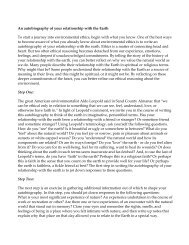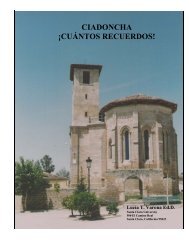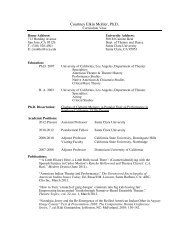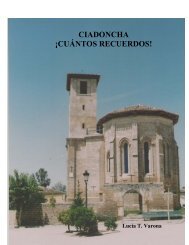*Winter 2001 Magazine CR - Webpages at SCU - Santa Clara ...
*Winter 2001 Magazine CR - Webpages at SCU - Santa Clara ...
*Winter 2001 Magazine CR - Webpages at SCU - Santa Clara ...
You also want an ePaper? Increase the reach of your titles
YUMPU automatically turns print PDFs into web optimized ePapers that Google loves.
By Adam BreenA winter trip to Mexico is a vac<strong>at</strong>ion for most people, but fora dedic<strong>at</strong>ed group of doctors and volunteers, it’s a mission of mercy. <strong>SCU</strong>Associ<strong>at</strong>e Professor Bill Stover and other members of The Flying Doctors (LosMedicos Voladores) don<strong>at</strong>e their time year-round to help people in rural Mexicanvillages where there is little or no medical or dental care available. Stover sayshe almost always returns from the four-day trips mentally and physically drained.Seeing children whose broken bones were never properly set or adults whose teethare rotting from a lack of care takes its toll on him. But he keeps going backbecause he knows the p<strong>at</strong>ients seen by The Flying Doctors have no other options.ALL PHOTOGRAPHY BY BILL STOVER“The pleasure of seeing good done—real, immedi<strong>at</strong>e results—certainly outweighsthe hardships,” says Stover, whohas been a pilot and de facto medicalassistant on these trips for 15 years. “It’sexhausting work. Some of the places wego are not very clean. We sleep on a bedth<strong>at</strong> sags in a room with cobwebs. I get alot of heartache out of it, and yet a lot ofpleasure in seeing medical care broughtto these people who otherwise wouldhave none.”For 26 years, The Flying Doctorshave been sending doctors, dentists,nurses, and interpreters from Northern California toremote regions of northern Mexico, where they set up aclinic and see as many p<strong>at</strong>ients as they can from sunriseto l<strong>at</strong>e <strong>at</strong> night. Everyone volunteers. No one gets paid.In fact, every member of the volunteer entourage pays$200 and brings wh<strong>at</strong>ever medical equipment they mayneed, including needles, vaccines, and dental drills.On some occasions, The Flying Doctors are given aplace to sleep by the local authorities who invited them.Otherwise, they rent their own rooms and buy their ownfood. They typically arrive on a Thursday afternoon andsee p<strong>at</strong>ients until dark. On Friday, p<strong>at</strong>ients comethrough from 8 a.m. to 9 p.m., then again S<strong>at</strong>urdayfrom morning until mid-afternoon, when The FlyingDoctors head home.The focus of the trips is indigenous people or thosewithout medical care, says Stover, who teaches intern<strong>at</strong>ionalrel<strong>at</strong>ions and intern<strong>at</strong>ional law <strong>at</strong> <strong>SCU</strong>.“Most physicians get into the field, really, because ofhumanitarian concerns,” says Stover, who got involvedas a way to apply his interest in intern<strong>at</strong>ional rel<strong>at</strong>ions<strong>SCU</strong> Associ<strong>at</strong>e Professor Bill Stoverstands near the plane he flew to the islandof Cedros, off the coast of Mexico.and avi<strong>at</strong>ion. “They get so bogged downwith insurance companies and HMOs,the staff in their office…they are helpingothers but they often lose sight of it.“When they go down to Mexico, it’sso clear. They don’t have labs or expensiveequipment—they have their owndiagnostic skills. It’s kind of nice to goback to th<strong>at</strong> point … having to talk topeople to figure out wh<strong>at</strong>’s wrong withthem.”In mid-February, Stover and anotherpilot flew a dentist and a medicalassistant to Isla de Cedros, a Pacificisland of 3,000 people 15 miles off the mainlandwhere the main industry is processing salt from thesea for shipment to Asia. His journal charts the tripand chronicles the good work The Flying Doctors dowith no fanfare.Friday, February 164 a.m. “The we<strong>at</strong>her looks fine as far south as theborder and also to Cabo San Lucas. We’re going halfwaybetween the border and Cabo. The Isla de Cedros doesn’treport we<strong>at</strong>her. We are going to pick up the one dentistwho’s going with us in Oakland, so it looks like a go.”7:35 a.m. “We’re airborne. This is my job, gettingthe medical professionals on st<strong>at</strong>ion to provide care.Vamanos.”11:15 a.m. “At Mexicali, we stop for immigr<strong>at</strong>ionand basically, we’re halfway there.”3:06 p.m. “We’re approaching Guerro Negro, a placewhere we can get some fuel. It’s $5 a gallon for fuel, butit’s the only place to get it, so th<strong>at</strong>’s wh<strong>at</strong> we have to do.SANTA CLARA MAGAZINE/SUMMER <strong>2001</strong> 15













